You are here: Foswiki>Boost2010 Web>HadronicWGWriteup>PerformanceChecks>GroomedMassComparisonsSinglePt (12 Sep 2010, GavinSalam)Edit Attach
Groomed Mass Comparison plots (single pt bin, Gavin's version)
The approach taken here is to concentrate on the 500-600 GeV pt bin. The logic is that this is a region where tops start to be convincingly boosted while maintaining at least some cross section for producing them. Also if we're asking the basic question "Does a given groomer help?", then with a single pt bin the choice of parameters is potentially simpler. Once that first question has been answered, one can then go on to investigate how best to make things work across multiple pt bins. NB: for anyone planning on trying the exercise across multiple pt bins, bear in mind that it may be beneficial to adapt parameters as a function of pt (for example, if the opening angle between subjets is Rjj, for filtering in the BDRS case, we found Rfilt=min(0.3,Rjj/2) as a reasonable first choice).Optimising each groomer
For the purpose of this page, the procedure I've followed is to do a manual parameter optimisation, for top-mass reconstruction, for each of the three groomers.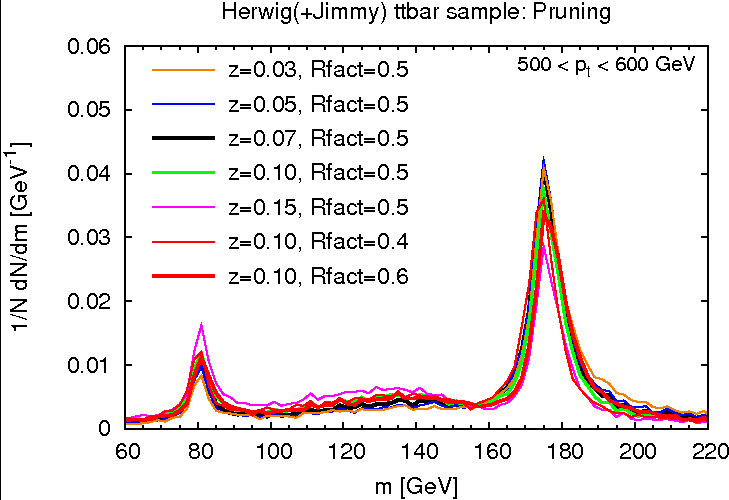 The parameters we'll take for pruning are: z=0.05 and Rfact=0.5.
The parameters we'll take for pruning are: z=0.05 and Rfact=0.5.
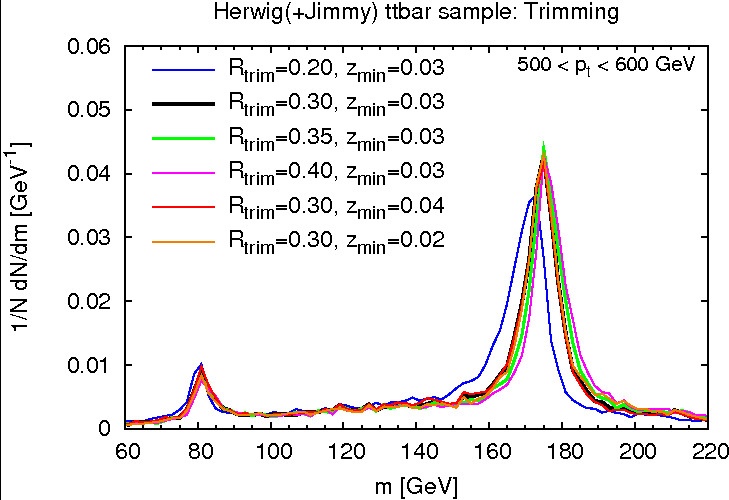 The parameters we'll take for trimming are Rtrim=0.35, zmin=0.3
The parameters we'll take for trimming are Rtrim=0.35, zmin=0.3
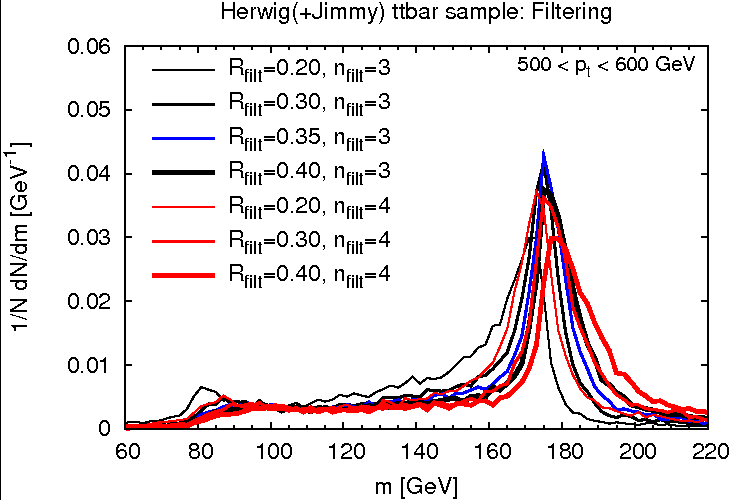 The parameters we'll take for filtering are Rfilt=0.35, nfilt=3.
The parameters we'll take for filtering are Rfilt=0.35, nfilt=3.
Caveats
In all the above plots, be aware of the fact that the choice of binning can affect the "visual" impact of a given plot: a choice that looks better with one binning may suddenly appear worse if you double the bin size. Since the above optimisation is a rough one, I've not worried about this effect too much, but it can be relevant.Comparing groomers
Signal
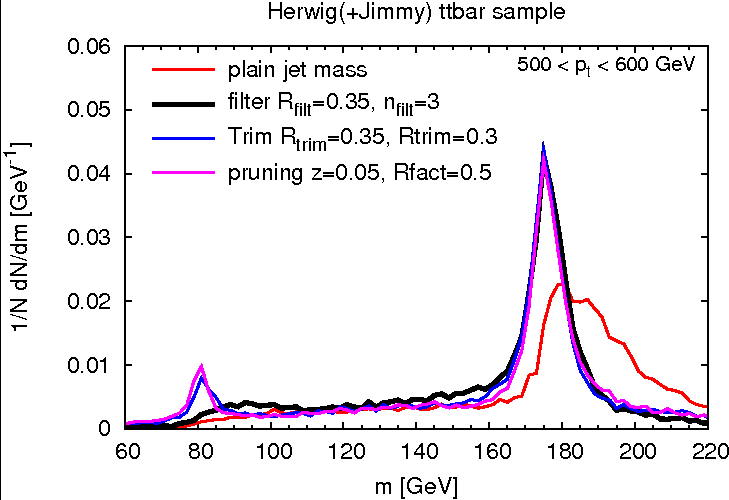 The conclusion from this plot is that the three groomers are doing identically in the region of the top mass and significantly better than the plain jet mass. In pruning and trimming, you also see a small W mass peak (not present in the raw jets).
To gauge the impact of these differences between groomed and ungroomed jets in an experimental context, one rough exercise one can perform is to smear each of the curves with a Gaussian of width 10GeV (an optimistic estimate for the experimental jet-mass resolution?):
The conclusion from this plot is that the three groomers are doing identically in the region of the top mass and significantly better than the plain jet mass. In pruning and trimming, you also see a small W mass peak (not present in the raw jets).
To gauge the impact of these differences between groomed and ungroomed jets in an experimental context, one rough exercise one can perform is to smear each of the curves with a Gaussian of width 10GeV (an optimistic estimate for the experimental jet-mass resolution?):
 While the improvement coming from grooming is significantly less dramatic than in the unsmeared case, some improvement still is present.
While the improvement coming from grooming is significantly less dramatic than in the unsmeared case, some improvement still is present.
Background
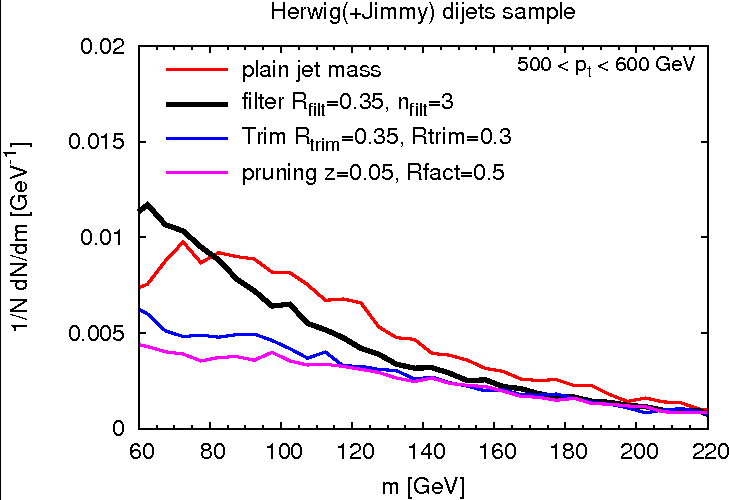 For the backgrounds, all three groomers show very similar behaviour near the top mass, with only marginal improvement relative to plain jets. This is probably because at these masses we are in any case close to the kinematic limit of what can fit into a jet, forcing the subjets to be rather hard, and so pass all the trimming/pruning/filtering cuts (compare with pruning in the validation samples, at much higher pt, where pruning did have an effect on the background). At smaller masses there are significant differences between the groomers, and there pruning and trimming both suppress the background somewhat more. Note that filtering is not intended to have a background-suppression effect in this region (for that, one should use all the other subjet-type methods being developed).
-- GavinSalam - 12 Sep 2010
For the backgrounds, all three groomers show very similar behaviour near the top mass, with only marginal improvement relative to plain jets. This is probably because at these masses we are in any case close to the kinematic limit of what can fit into a jet, forcing the subjets to be rather hard, and so pass all the trimming/pruning/filtering cuts (compare with pruning in the validation samples, at much higher pt, where pruning did have an effect on the background). At smaller masses there are significant differences between the groomers, and there pruning and trimming both suppress the background somewhat more. Note that filtering is not intended to have a background-suppression effect in this region (for that, one should use all the other subjet-type methods being developed).
-- GavinSalam - 12 Sep 2010 | I | Attachment | Action | Size | Date | Who | Comment |
|---|---|---|---|---|---|---|
| |
mass-test-4algs-bkgd-rebin5.png | manage | 7 K | 12 Sep 2010 - 15:21 | GavinSalam | |
| |
mass-test-4algs-smear10.png | manage | 6 K | 12 Sep 2010 - 15:09 | GavinSalam | |
| |
mass-test-4algs.png | manage | 8 K | 12 Sep 2010 - 15:09 | GavinSalam | |
| |
mass-test-filter.png | manage | 8 K | 12 Sep 2010 - 15:09 | GavinSalam | |
| |
mass-test-prune.png | manage | 8 K | 12 Sep 2010 - 15:09 | GavinSalam | |
| |
mass-test-trim.png | manage | 8 K | 12 Sep 2010 - 15:14 | GavinSalam |
Edit | Attach | Print version | History: r1 | Backlinks | View wiki text | Edit wiki text | More topic actions
Topic revision: r1 - 12 Sep 2010, GavinSalam
 Copyright © by the contributing authors. All material on this collaboration platform is the property of the contributing authors.
Copyright © by the contributing authors. All material on this collaboration platform is the property of the contributing authors. Ideas, requests, problems regarding Foswiki? Send feedback


